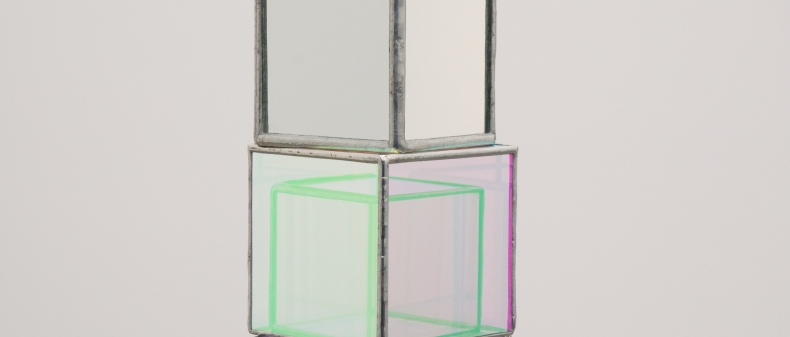
Object of Contemplation (Multidimensional Gateway), by Elizabeth Zvonar (2009)
The Daniel Faria Gallery is having an austere summer. Their summer group show, curated by Rui Amaral, is focused entirely on geometry; but “focused” doesn’t quite do justice to the kind of formal dedication currently filling the gallery’s front and back exhibition spaces. There are, quite simply, no organic forms to be found anywhere, and even then, the show is entirely given over to two precise shapes: the circle and the square.
The show is called New Meditations, and takes its cue from the polestars of geometric abstraction and high Modernism: Kazimir Malevitch, Josef Albers and Sol LeWitt. Parenthetically, it’s interesting to note what has become of these art-historical toilers — how contemporary artists adopt them as gurus, rediscovering, fetishizing and deconstructing these innovators who lie just outside the popular canon. About ten years ago, figurative artists seemed to converge in their orbit around Francis Picabia and Martin Kippenberger; hard-edged abstract artists have embraced Russian Constructivism with the same fervor.
Of course, these systems of influence have been perpetuating themselves for a long time now, and how these artists get processed in turn determines how the public reacts to the work. There is a distinct aroma of spiritualism to the Russian Constructivists that, in some sense, still dictates how that kind of abstraction is made. Think of the grandiose claims to Sublimity made by more typically canonical artists like Barnett Newman and Mark Rothko: paintings as vibrations emanating from an ineffable Jungian subsconscious, elemental gestures that recall the divine division of light and dark; just as the Russian Constructivists exerted a formal influence, these claims are interpretive emanations of their conceptual influence.
The Russian Constructivists (some of them, anyway) were followers of Madame Blavatsky, a Theosophist who believed in the potential for communication with the spirit world, a world of pure form (I’m oversimplifying). And so, corollary to the avant-garde pursuit of abstraction for its own sake was a desire for art to be able to open those channels of communication. Hence, New Meditations can be taken literally — these contemporary artists meditating anew on their precedents — or metaphorically — much of the work here has a spiritual aspect.
Jose Davila attempts to bring the formal experiments of Josef Albers into three dimensions; his Homage to the Square sculptures involve leaning incrementally smaller panes of glass onto a portion of wall, painted a specific Pantone color. I can see the intent — that the increasingly heavy filter of glass atop the painted surface is meant to introduce subtle gradations of color, a la Albers — but in reality, it’s hampered by shortcomings in its execution; the glass is too reflective, and any colour alteration is obscured by the myriad reflections in its layered planes.
Douglas Coupland grafts a kind of cynical anti-consumerism onto his abstractions: His Snowman prints pile target patterns piled atop one another that look conspicuously like corporate logos, and in Live Free or Die, a scan code is tarted up to look like a Mondrian. The work is made slightly more interesting by the show’s spiritualist context, but ultimately, I find Coupland facile and glib.
Jessica Eaton’s photographs, in which she captures arrangements of cubes, are a particular standout. Each of her cubes are painted white, black and varying shades of grey. Eaton then processes the pictures through various coloured filters. The exposures are vivid, rich and saturated, and they undo space altogether — the figures read as fields of light rather than concrete objects.
The show really belongs to Derek Liddington, however. In the back gallery, he has four graphite drawings, Horizon Studies, circles and semi-circles of varying intensities of black and grey. They each have long, self-explanatory parenthetical titles, for example, The exact moment the sun penetrates the surface of the water resulting in multiple reflections which, upon closer inspection, resemble a figure eight that has been crushed in on itself (2012). The portentous labels belie the breezy playfulness of these drawings. There is a tranquil rhythm to them; these spheres and hemispheres are dancing with each other, echoing each other, and are quite blissful in their way. They have the tasteful ease of an Alex Katz painting, distilling the visual complexities of the movement of the heavens into serene amblings of geometry.
In the front gallery, in A Love Story Between 3 Squares (1959), Liddington goes full guns. It’s a massive wall installation, a solid graphite drawing of three squares overlapping. The three squares are contained within a single square field, tilted on its side: the shapes jostle and grapple and warp each other, odd curves and angles unfolding within their respective borders. Formally, it’s astounding, a bravura display of rhythm and gesture. It’s also texturally sumptuous, a thick silvery patina of graphite; in the surface’s sheen, you can see the expressive verve of his aggressive drawing.
If there’s any criticism to be leveled at New Meditations, it’s that, overall, it’s a bit too matchy-matchy (to borrow a phrase from Nina Garcia); in its unflagging fealty to the hard-edge and the clean line, the show comes off at times as limited by an excess of taste, occasionally teetering closer to design than art. It would have been nice to see something just a little bit messy, some difference in approach to offset all the carefully angled precision. But while the show isn’t exactly what I’d call fun, it is never dry. For a collection devoted to minimalistic concerns, it is airy and light, poised and graceful. As far as summer confections go, it’s not a wild crowd-pleaser; more like a pair of crisp linen trousers, or a lemon sorbet: sleek and clean, substantive without being heavy.
New Meditations continues at Daniel Faria Gallery until September 15.
______
Sholem Krishtalka is the Toronto Standard’s art critic.
For more, follow us on Twitter at @torontostandard, and subscribe to our newsletter.











